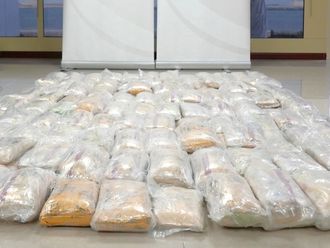
Dubai: Behind the high-security gates and concrete walls of the Dubai Central Jail in Al Aweer, inmates keep themselves busy.
One team has been working on creating beautiful pieces of handicraft. The result: a potentially record-setter. It is made of 35,000 cardboard boxes, and is on the way to setting a fresh record for the world’s biggest cardboard sculpture.
It’s part of the programme where inmates acquire new skills to prepare them for post-correctional life. In this exclusive visit by Gulf News arranged by the facility’s Department of Education and Training, we met inmates who made the world’s largest cardboard sculpture, modelled after the Shaikh Zayed Grand Mosque in Abu Dhabi.
Innovation
The uplifting story about how it started inspires fascination. The jail facility, which values suggestions from inmates, has an “innovation club”. One such idea was to build the world’s largest cardboard sculpture modelling Sheikh Zayed Grand Mosque.
Gulf News met the inmates in charge of the project, which now stands in the department’s car park.
Maj. Mohammad Abdullah Al Obaidli, Director of the Department of Education and Training, told Gulf News: "The ideas and creativity of inmates are fascinating," and shows that even within the confines of such a facility, human imagination is limitless.

The ideas and creativity of inmates are fascinating.
Largest replica of Sheikh Zayed Grand Mosque
For this project, a group composed of 13 inmates, from 11 nationalities has been put together. They worked for two years to produce their masterpiece — the largest cardboard replica of the Sheikh Zayed mosque.
The goal: set a new Guinness World Record.
One of the inmates (who declined to be named) in charge of the project told Gulf News : “I came to the UAE in 1999 and I loved the design of the Sheikh Zayed mosque, so I studied it and sought to build the biggest cardboard model by 2021.”
Dimensions: Inmates used the architects’ drawings of the original mosque to achieve the required precision. The huge sculpture is 16 metres long, 11.5 metres wide and 6.85 metres high.
35,000: Number of recycled cardboard boxes used for the project.

Teamwork
The story of how such an astonishing model emerged from the gloomy surroundings of a corrective institution is a tale of remarkable perseverance, teamwork and a willingness from all sides to dream, think big, and make things happen.
The story started in January 2018. One of the inmates, a European, had been active in the Education Department teaching a variety of successful classes including English language, drawing and painting. He is spending 15 years in jail and still serving his sentence.
The inmate in charge of project told Gulf News that Maj. Al Obaidli challenged him saying: “Do you have any ideas about how we can expand the art department? Try and think of something big. I want to expand the range of what we do in the Education Department.”
The inmate rose to the challenge. He planned to make some kind of model. He bounced ideas around, knowing that any project that he came up with needed to be both large enough to meet the officer’s challenge — but also practical in terms of the materials and man power available.

Starting point
The challenge given by the senior official, Maj. Al Obaidi, had been made just as the UAE was starting 2018, designated the “Year of Zayed”.
The whole year was going to be devoted to celebrating the achievements of the UAE’s founding father and first president, Shaikh Zayed bin Sultan Al Nahyan.
Abu Dhabi’s magnificent Shaikh Zayed Grand Mosque signifies both the UAE and the wider Islamic world.
The inmate also had an extra advantage: he had previously worked as a consultant with the construction of the original mosque. The plan was then set in motion.
7,900 architectural drawings, 3D visuals
“I wanted to create something of a very high standard, and I knew that we would need help,” said the inmate.
Jail authorities contacted construction giant Halcrow. The company’s project director visited the prison and arranged for the inmates to get the full set of ‘as-built’ 7,900 architectural drawings — and some 3D visuals from their work on the original mosque.”
“Therefore, I decided to make a model of the Grand Mosque from whatever waste we could find in the prison, where a huge amount of waste cardboard and plastic is generated. My initial thought was to aim for something with an area of about five square metres.”
He took the idea to Corporal Aamir Miran, and then up to Lt Ali, and then finally to Major Al Obaidli — who accepted that the idea met his challenge — and more.
Testing cardboard materials
The first task was to test the various kinds of cardboard. Another challenge: mastering the process of scaling the drawings to design a realistic model.
Then an idea popped up: The inmate began to think of increasing the size of the model, so that it would be the largest such model in the world.
The jail guards were equally enthusiastic.
Guinness record
The force then invited the Dubai representatives of Guinness Book of World Records to visit Al Aweer central jail. This meant that the mosque’s four minarets would be 6.85 meters high — higher than a flat-roofed two-story house.
The Guinness representative confirmed that if the size is achieved, the model would set the record for being “the largest cardboard sculpture”.
The Guinness rep also told the team that the holder of the current world record for the "largest cardboard sculpture" is Full Sail University in Florida, USA.
"We wanted to surpass the Florida sculpture, and therefore the model had to be approximately 16 meters long by 11.5 meters wide — slightly larger than a tennis court,” said the inmate.
The Guinness people then confirmed that if the Dubai team hit this size, the model would be "the largest cardboard sculpture" in the world.
In addition, Guinness defined the terms, including the materials allowed to be used in building such a model. They also required an audit of the work while in progress in the prison with remote GoPro cameras, digital and other photo evidence. Major Al Obaidli immediately organised the delivery of the required GoPro camera into the team's working environment.
Prototype
In October 2018, the work started on five meter–wide prototype in the prison workshop. By January 2019, a full team of 13 inmates were gathered from 11 nationalities with an inevitable mix of languages, cultures and vast gap in experiences.
There was an initial challenge of ensuring that everyone could work despite the language barrier. If the team spotted problems, ideas were invited for solutions so that they could move on quickly.
Nothing could delay the whole project.
The main structures were completed first. That’s when the size and shape of the final mosque was clear. The next step: give the entire model a uniform covering. This process started with the eight large signature domes. The team had to cover up the still-visible squares of cardboard used in their construction.
A Dubai company also gave the project a supply of thin golden-coloured cardboard sheets. A decision was made to cover the entire model with the same finishing cardboard.

No paint
“There had been a plan to paint the model, but I resisted that idea because I wanted to keep the cardboard look which made very clear that the model was created from cardboard,” the inmate said.
After having covered the domes, the team continued and covered every wall. All the intricate details were covered. This helped achieve the desired consistency in finishing and style.
Like the original mosque, we wanted a single consistent colour scheme across the whole building. The original is all white marble, and ours is now all golden cardboard.
“Like the original mosque, we wanted a single consistent colour scheme across the whole building. The original is all white marble, and ours is now all golden cardboard,” said the inmate.
Because the whole model was too big to be assembled in its all its seen glory in the workshop, the team had never seen the entire structure in one place.
All they had seen were the two halves in the workshop that they had built to check that the sculpture would come together properly.
This changed in November 2021 when it was decided to erect the entire model in the car park outside the prison workshop, in preparation for a visit by several senior police officers.
It took two and half hours to join together the whole model. The team’s immense efforts were amply rewarded.
What's next
Jail officials are in talks with the owners of a new mall where the cardboard sculptor will be displayed for the public to see.



















